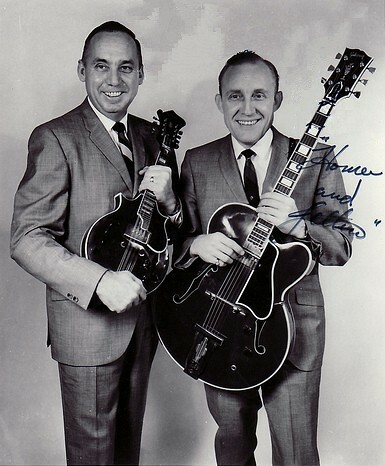Introduction to Homer and Jethro
Homer and Jethro were an American country and parody duo consisted of Henry D. Haynes (“Homer,” 1920-1971) and Kenneth C. Burns (“Jethro,” 1920-1989); they were also dubbed as the “Thinking Man’s Hillbillies.” They started working together as a duo when they were just 16 while auditioning at a radio station in Knoxville, Tennessee. Roughly three years later they became regulars on a radio show called Renfro Valley Barn dance in Dayton, Ohio. They served in the US Army during the World War II but in separate destinations. Upon their respective discharges, Homer and Jethro got back together again and around that time, and that’s where they also launched their line of parody songs. At that point also, they started their recording career, first signed to King label and then to RCA Victor I 1949. Their first charting single was “I Feel the Old Age Creeping On” but gained recognition through their parody of “Baby It’s Cold Outside” with June Carter. Their self-deprecating brand of humor was a click amongst audiences. Homer and Jethro’s other notable hit singles were “(How Much Is) That Hound Dog in the Window” and “Hernando’s Highway.” They also appeared on other projects such as The Ford Show, Starring Tennessee Ernie Ford, as well as for Kellogg’s Corn Flakes advertisements. Haynes – or Homer – died in 1971, and Burns (or Jethro) moved on, first replacing Haynes with Ken Edison but this lineup didn’t last long, so Burns continued performing and recording on his own. He died in 1989, aged 68. Homer and Jethro were inducted into the Country Music Hall of Fame in 2001.
Early life and career of Homer and Jethro
Henry D. Hayes (July 27, 1918- August 7, 1971) and Kenneth C. Burns (March 10, 1923- February 4, 1989) were American country music duo popularly known as Homer and JethroBoth born and raised in Tennessee, the two met during an audition for the local radio station WNOX-AM and began playing together. Haynes played the guitar while Burns played the mandolin and banjo. Program director Lowell Blanchard gave their first stage names as Junior and Dude (pronounced as “dood-ee”). Around that time, they also became part of the group, the String Dusters and later became regulars of another radio program Renfro Valley Barn Dance in Renfro Valley, Kentucky.
During World War II, the duo paused for a while from performing and served the US Marine separately; Hayes served in Europe while Jethro was in the Pacific theatre. The two were later discharged from their respective duties and reunited in Knoxville in 1945. Two years later they began making radio appearances again. They also worked on King Label as session musicians for the label’s acts.
Homer and Jethro’s hits
Homer and Jethro also appeared on WLW-AM’s Midwestern Hayride in Cincinnati, Ohio, singing several pop tunes in comedic and exaggerated hillbilly renditions. In 1949, they were signed in RCA Victor label where they cut their records for the most of their careers. Later that year, they issued “Baby It’s Cold Outside” which became their first hit. It made to the Top 40 of the Billboard pop chart at #22. The song was followed by more successful hits such as “(How Much) is that Hound Dog in the Window” which peaked at #17 pop on 1953 and “The Battle of Kookamonga” which reached #14 pop in 1959. Their parody of Johnny Horton’s hit “The Battle of New Orleans” won a Grammy award for Best Comedy Performance in that same year.
Later years
During the 1960’s, Homer & Jethro’s career was starting to slow down but the releasing of records was continuous. By 1966-1967 alone, they issued eight records. In 1966, they also performed at the grand opening ceremony of the Dixie Square Mall in Harvey, Illinois.
They continued to perform until the half of the duo, Haynes died in 1971. In order to continue as Homer and Jethro, Burns hired a new “Homer” in Ken Edison, but this new line-up was short-lived. Burns later become a solo recording artist. By that time he was performing and touring with Chicago folksinger Steve Goodman and became a master teacher in mandolin jazz. On February 4, 1989, he died from prostate cancer in Evanston, Illinois. In 2001, Homer and Jethro were inducted into Country Music Hall of Fame.

